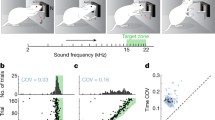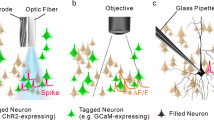Summary
Single unit activity was recorded from complex spike cells in the hippocampus of the rat while the animal was performing a spatial memory task. The task required the animal to choose the correct arm of a 4 arm plus-shaped maze in order to obtain reward. The location of the goal arm was varied from trial to trial and was identified by 6 controlled spatial cues which were distributed around the enclosure and which were rotated in step with the goal. On some trials these spatial cues were present throughout the trial (spatial reference memory trials) while on other trials they were present during the first part of the trial but were removed before the rat was allowed to choose the goal (spatial working memory trials). On these latter trials the animal had to remember the location of the cues and/or goal during the delay in order to choose correctly. 55 units were recorded during sufficient reference memory trials for the relationship between their firing pattern and different spatial aspects of the environment to be determined. 33 units had fields with significant relations to the controlled cues while 16 had significant relations to the static background cues, those cues in the environment which did not change position from trial to trial. Of 43 units which could be tested for their relation to the shape of the maze arms themselves, 15 showed such a relationship. Therefore the place units can be influenced by different aspects of the spatial environment but those related to the task requirement appear to be more potent. Interaction effects between the different spatial factors also influenced the firing pattern of some units. Of particular interest was the interaction between the controlled cues and the static background cues found in some cells since this might shed some light on how the hippocampus enables the rat to solve the memory task. 30 units with place fields related to the controlled cues were recorded during successful performance on spatial working memory trials as well as during spatial reference memory trials. The place fields of 90% of these units were maintained during the retention phase of the memory trials. During the recording of some units, other types of trial were given as well. On control trials, the cues were removed before the rat was placed on the maze. These trials provided controls for the potential influence of information left behind by the controlled cues and for the influence of the animal's behaviour on the unit activity. They also provided information about the unit firing in the absence of the controlled spatial cues and about the animal's choice of goal under these circumstances. During control trials, the units typically maintained their place fields but these fields had no relation to the experimenter-defined goal. The rat's choice of goal arm at the end of the trial, however, continued to show the usual spatial relationship to the fields. The data from these control trials, taken together with the interaction between the controlled cues and the static background cues seen in some of the cells and the characteristic mistakes made by each rat, suggest that the animal enters the task on each trial with an expected or preferred orientation of the controlled spatial cues relative to the background cues and that it must reorient its cognitive map of the environment or search for a different map when the actual orientation of the controlled cues departs from this default condition. Detour trials differed from working memory trials in that the animal was not immediately allowed to choose the goal at the end of the retention period but was forced to enter a non-goal arm instead. These trials ruled out the possibility that the animal was remembering the specific turn required to reach the goal and demonstrated that the place fields for the entire maze are set up as a result of exposure to the controlled spatial cues in any one of the start arms. Overall, the results provide strong support for the cognitive map theory of hippocampal function. In particular, they demonstrate that the representations of places within an environment are connected together to form a map, that the orientation of this map relative to an environment can be changed from trial to trial, and that this orientation is “remembered” following the removal of the controlled spatial cues.
Similar content being viewed by others
References
Ainsworth A, O'Keefe J (1977) A light microdrive for the simultaneous recording of several units in the awake, freely-moving rat. J Physiol (Lond) 269: 8–10P
Andersen P, Eccles JC, Loyning Y (1964) Location of postsynaptic inhibitory synapses on hippocampal pyramids. J Neurophysiol 27: 592–607
Andersen P, Silfvenius H, Sundberg SH, Sveen O (1980) A comparison of distal and proximal dendritic synapses on CA1 pyramids in guinea-pig hippocampal slices in vitro. J Physiol (Lond) 307: 273–299
Barnes CA, McNaughton BL, O'Keefe J (1983) Loss of place specificity in hippocampal complex spike cells of senescent rat. Neurobiol Aging 4: 113–119
Best PJ, Ranck JB (1982) Reliability of the relationship between hippocampal unit activity and sensory-behavioural events in the rat. Exp Neurol 75: 652–664
Buzsaki G, Leung LS, Vanderwolf CH (1983) Cellular bases of hippocampal EEG in the behaving rat. Brain Res Rev 6: 139–171
Hays WL (1973) Statistics for the social sciences, 2nd edn. Holt Rinehart and Winston, London ]
Hill AJ (1978) First occurrence of hippocampal spatial firing in a new environment. Exp Neurol 62: 282–297
Kandel ER, Spencer WA, Brinkley FJ (1961) Electrophysiology of hippocampal neurons. I. Sequential invasion and synaptic organisation. J Neurophysiol 24: 225–242
Kubie JL, Fox SE, Muller RU (1984) Variations in place firing with the state of the hippocampal EEG. Soc Neurosci Abstr 10: 599
Kubie JL, Muller RU, Ranck JB (1983) Manipulations of the geometry of environment enclosures control the spatial firing patterns of rat hippocampal neurons. Soc Neurosci Abstr 9: 646
Kubie JL, Ranck JB (1983) Sensory-behavioural correlates in individual hippocampus neurons in three situations: space and context. In: Seifert W (ed) Neurobiology of the hippocampus. Academic Press, London, pp 433–447
McNaughton BL, Barnes CA, Andersen P (1981) Synaptic efficacy and EPSP summation in granule cells of rat fascia dentata studied in vitro. J Neurophysiol 46: 952–966
McNaughton BL, Barnes CA, O'Keefe J (1983) The contributions of position, direction and velocity to single unit activity in the hippocampus of freely-moving rats. Exp Brain Res 52: 41–49
McNaughton BL, O'Keefe J, Barnes CA (1983) The stereotrode: a new technique for simultaneous isolation of several single units in the central nervous system from multiple unit records. J Neurosci Meth 8: 391–397
Merrill EG, Ainsworth A (1972) Glass-coated platinum-plated tungsten microelectrodes. Med Biol Eng Comput 10: 662–672
Miller VM, Best PJ (1980) Spatial correlates of hippocampal unit activity are altered by lesions of the fornix and entorhinal cortex. Brain Res 194: 311–323
Muller RU, Kubie JL, Ranck JB (1983) High resolution mapping of the ‘spatial’ fields of hippocampal neurons in the freely moving rat. Soc Neurosci Abstr 9: 646
Muller RU, Kubie JL, Ranck JB (1987) Spatial firing patterns of hippocampal, complex-spike cells in a fixed environment J Neurosci 7: 1935–1950
O'Keefe J (1976) Place units in the hippocampus of the freely moving rat. Exp Neurol 51: 78–109
O'Keefe J (1979) A review of the hippocampal place cells. Prog Neurobiol 13: 419–439
O'Keefe J (1983) Spatial memory within and without the hippocampal system. In: Seifert W (ed) Neurobiology of the hippocampus. Academic Press, London, pp 375–403
O'Keefe J, Conway DH (1978) Hippocampal place units in the freely-moving rat: why they fire where they fire. Exp Brain Res 31: 573–590
O'Keefe J, Conway DH (1980) On the trail of the hippocampal engram. Physiol Psychol 8: 229–238
O'Keefe J, Dostrovsky J (1971) The hippocampus as a spatial map. Preliminary evidence from unit activity in the freely-moving rat. Brain Res 34: 171–175
O'Keefe J, Nadel L (1978) The hippocampus as a cognitive map. Clarendon Press, Oxford
Olton DS (1978) Characteristics of spatial memory. In: Hulse SH, Fowler H, Honig WK (eds) Cognitive processes in animal behavior. John Wiley, New York, pp 341–373
Olton DS, Becker JT, Handelmann GE (1979) Hippocampus, space and memory. Behav Brain Sci 2: 313–365
Olton DS, Branch M, Best P (1978) Spatial correlates of hippocampal unit activity. Exp Neurol 58: 387–409
Olton DS, Walker JA, Gage FH (1978) Hippocampal connections and spatial discrimination. Brain Res 139: 295–308
Parkinson JK, Mishkin M (1982) A selective mnemonic role for the hippocampus in monkeys: memory for the location of objects. Soc Neurosci Abstr 8: 23
Ranck JB (1973) Studies on single neurons in dorsal hippocampal formation and septum in unrestrained rats. Exp Neurol 41: 461–555
Scoville WB, Milner B (1957) Loss of recent memory after bilateral hippocampal lesions. J Neurol Neurosurg Psychiat 20: 11–21
Smith ML, Milner B (1981) The role of the right hippocampus in the recall of spatial location. Neuropsychologia 19: 781–793
Winer BJ (1971) Statistical principles in experimental design, 2nd edn. McGraw-Hill, New York
Author information
Authors and Affiliations
Rights and permissions
About this article
Cite this article
O'Keefe, J., Speakman, A. Single unit activity in the rat hippocampus during a spatial memory task. Exp Brain Res 68, 1–27 (1987). https://doi.org/10.1007/BF00255230
Received:
Accepted:
Issue Date:
DOI: https://doi.org/10.1007/BF00255230




